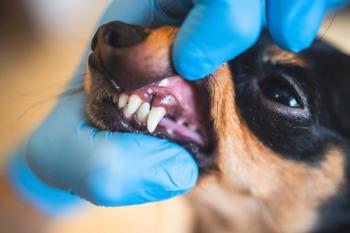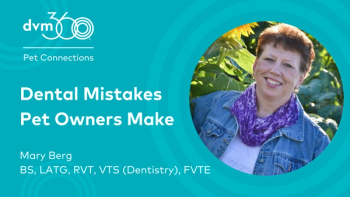
Wildlife dentistry: Encounters with the truly exotic
How a foundation is keeping all creatures wild and wonderful in good oral health-and how you can help.
This lion at the Exotic Feline Rescue Center in Center Point, Ind., will undergo a thorough oral evaluation and receive any necessary treatment thanks to a program that helps treat dental problems in wildlife.
Hundreds of wildlife sanctuaries in this country and abroad rescue and care for lions, tigers, jaguars, chimps, rhinos and elephants, plus whatever wanders in. Many of these animals have serious dental lesions that not only cause pain but also threaten their survival. Tooth morphology varies greatly across the exotic species. The sheer size of their teeth requires special equipment, materials and hard-to-find information on how to perform procedures correctly.
Peter Emily, DDS, has stepped up to help these special patients. As a dentist based in Colorado, he has more than 40 years of human and veterinary dental experience. Undoubtedly, he has performed more dental procedures on exotic animals than any human on the planet.
“I became involved in helping veterinarians thanks to my life as a Doberman pinscher show judge,” says Emily. “Veterinarians were eager to know more about dentistry, and I was ready and willing to help.”
Soon Emily was called to help with exotics and developed novel ways to use his human dental knowledge-particularly in periodontics and endodontics-to benefit these large animals that often suffered silently. As often happens, Emily got what he wished for but found there was more work to do than available time. He needed a solution, and he wanted a way to pass on his knowledge to the next generation or much of it would be lost forever.
Dr. Peter Emily shares a dental gem with Dr. Robert Baratt.
A foundation begins…
In 2005 through Emily's warm relationship with many of the boarded veterinary dentists, the Peter Emily International Veterinary Dental Foundation (PEIVDF) was created. Emily provided initial funds (more than $300,000) to purchase needed dental equipment and materials, plus the legal and accounting fees to create the foundation.
PEIVDF's mission is twofold:
1. To provide veterinary dental services to exotic animal sanctuaries free of charge that are understaffed or underfunded
2. To increase the availability of exotic animal dental education by providing the opportunity to gain hands-on experience in multiple exotic species in the form of teaching missions.
The missions not only provide needed care but mentor veterinarians and technicians in the science and art of wildlife dentistry. The foundation is guided by the board of directors who elect a president, a secretary-treasurer and an advisory board. A managing director cares for the day-to-day responsibilities. Quarterly board meetings are held in person or electronically.
An endodontic tray with large endodontic files and a drill necessary for wildlife dentistry.
A major expense for the foundation is the cost of specialized equipment and supplies necessary to perform varied procedures on a multitude of species, including portable radiology generators, power equipment and almost innumerable consumable supplies. This extensive array of equipment and supplies must be shipped, often cross-country, for each weekend teaching and treating mission. A typical weekend mission at a wildlife sanctuary can cost the foundation between $5,000 and $10,000. With less than half of the original seed money left, the board of directors pays close attention to operating expenses and income.
A major program service of PEIVDF and vital source of funds is the tuition paid by volunteer veterinarians who participate in PEIVDF teaching missions. General practitioners as well as members of the American Veterinary Dental Society, Fellows of the Academy of Veterinary Dentistry and Diplomates of the American Veterinary Dental College pay tuition on a sliding scale based on experience, acquired skills and commitment to the PEIVDF charitable mission. The instructors, all boarded veterinary dentists, donate their time, and most pay their travel and hotel fees.
Quartermaster Kathy Pershing, CVT, and quartermaster trainee Ericka Jaramillo preparing materials for a mission.
On a mission
With multiple patients to treat in a weekend, organization is essential. Trips to treat exotic animals in sanctuaries are called missions. Each mission has a mission leader who chooses one or more team leaders; the number of teams is predicated on the number of patients to treat, staff practitioners, registered veterinarians (called mission workers) and technicians attending, and available operatories. Each team leader educates the registered veterinarians, keeps records and prepares reports of his or her team's dental care. A technician quartermaster and a quartermaster trainee manage equipment, radiograph units and materials.
My experience
I've attended two missions this year, both in Indiana at the Exotic Feline Rescue Center in Center Point, Ind. The center houses more than 230 lions, tigers, cheetahs, bobcats, leopards and jaguars.
On two days in March with the help of boarded anesthesiologists and students from the University of Illinois, we treated seven patients, performing 17 root canals and an oral biopsy. This past September we treated six patients, performing 23 root canal procedures and 18 surgical extractions.
On our latest mission, nine veterinarians and four technicians arrived late Friday and drove 20 miles to the hotel. We met Saturday at 6:15 a.m. for introductions, breakfast, group assignments and an in-depth safety discussion led by the mission leader, Kris Bannon, DVM, DAVDC. The safety of everyone, including the animals, was the top priority. Everyone was cautioned to be vigilant at all times. Balanced anesthesia and safe recovery of the animals were everybody's responsibility, not only the anesthesiologists'.
The sanctuary owner greeted us at 8:30 with a wonderful tour of the 100-acre facility. Other than the sizeable protective enclosures separating us, we were in a jungle.
Veterinary student Lisa Bourazak and boarded anesthesiologist Dr. Stuart Clark-Price intubating a tiger at the Exotic Feline Rescue Center in Center Point, Ind.
At 10 a.m. the first patient was wheeled into the operatory by the anesthesiologists. Once the tiger was intubated, our team leader, Barron Hall, DVM, DAVDC, triaged the tiger's mouth and asked Robert Baratt, DVM, to help obtain full-mouth intraoral radiographs.
Dr. Robert Baratt examining the tiger's oral cavity.
This patient had four complicated fractured canines that needed root canal therapy.
An extended drill length to reach the tiger's root canal.
Drs. Deborah Hodesson and Baratt and myself each chose a tooth and began drilling, filing, filling and restoring.
Six-handed dentistry.
Sterile pipe cleaners used to dry the root canals before placing sealer and gutta percha.
The anesthetists closely monitored the tiger's vitals and serum potassium concentration. Veterinary students on anesthesia rotation took shifts compressing the bag every five seconds hour after hour.
Dr. David Condon with the next patient.
In the adjoining operatory, team leader Clarence Sitzman, DVM, DAVDC, assisted by David Condon, DVM, was performing a root canal and a premolar extraction on a tiger.
A tiger with complicated mandibular canine fracture.
By noon, we were finished, and the tiger was transported back to its cage and extubated. Dr. Sitzman's team was finished by 1 p.m. Time to grab a quick bite from a table set with refreshments. New patients were delivered at 2 p.m. and treated for the next four hours.
An intraoral radiograph of the tiger showing a filled bulbous apex.
The tiger's fractured tooth has been restored.
Tooth resorption in a jaguar's canine.
An intraoral radiograph showing the extent of tooth resorption.
Pulp exposure on the jaguar's left mandibular fourth premolar and molar treated with root canal therapy.
We retired back to the hotel, showered and met for dinner at 7:45 p.m. Sunday morning started with a 7:30 breakfast, and then back to the sanctuary to treat a lion and two bobcats.
<
Ongoing needs
Our challenge is to sustain and grow the Peter Emily International Veterinary Dental Foundation. Even with the board of directors working pro bono, expenses for shipping, replenishing materials and purchasing capital equipment-as well as feeding those attending missions-create an ongoing financial strain. Sources of income include donations and student tuitions. Visit
A team effort: This group assisted patients at the Turpentine Creed Wildlife Refuge in Eureka Springs, Ark. Left to right: Dr. Ole Alcumbrac, Dr. Peter Emily, Dr. Jack Easley, Dr. Stephen Galloway, Lourdes Cuevo, Dr. Barron Hall, Dr. Curt Ritchie, Dr. Elizabeth McMorran, Dr. Clarence Sitzman and Kathy Pershing.
Future missions
Dec. 1-2, 2012: Noah's Ark Animal Rehabilitation Center, Locust Grove, Ga.
March 2013: Wildcat Sanctuary, Sandstone, Minn.
May 2013: Turpentine Creek Wildlife Refuge, Eureka Springs, Ark.
Summer 2013: Exotic Feline Rescue Center, Center Point, Ind.
September/October 2013: Wildcat Sanctuary, Sandstone, Minn.
Newsletter
From exam room tips to practice management insights, get trusted veterinary news delivered straight to your inbox—subscribe to dvm360.






